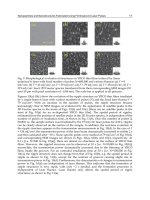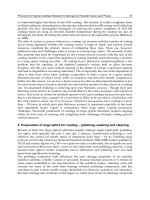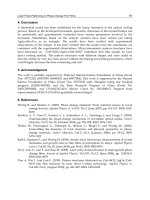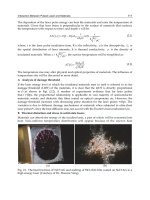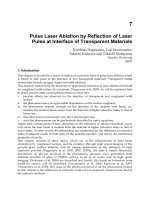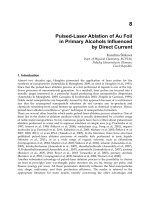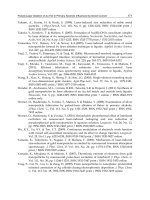Lasers Applications in Science and Industry Part 10 pptx
Bạn đang xem bản rút gọn của tài liệu. Xem và tải ngay bản đầy đủ của tài liệu tại đây (2.55 MB, 20 trang )
Pulsed-Laser Ablation of Au Foil in Primary Alcohols Influenced by Direct Current
171
Takami, A., Kurita, H. & Koda, S. (1999). Laser-induced size reduction of noble metal
particles. J.Phys.Chem.B, Vol. 103, No. 8, pp. 1226-1232, ISSN 1520-6106 print /
ISSN 1520-5207 online
Takeda, Y., Kondow, T. & Mafune, F. (2005). Formation of Au(III)-DNA coordinate complex
by laser ablation of Au nanoparticles in solution. Nucleoside, Nucleotides, and Nucleic
Acids, Vol. 24, No. 8, pp. 1215-1225, ISSN 1525-7770 print / 1532-2335 online
Tarasenko, N.V., Butsen, A.V. & Nevar, E.A.(2005). Laser-induced modification of metal
nanoparticles formed by laser ablation technique in liquids. Applied Surface Science,
Vol. 247, pp. 418-422, ISSN 0169-4332
Tsuji, T., Tsuboi, Y., Kitamura, N. & Tsuji, M. (2004). Microsecond-resolved imaging of laser
ablation at solid-liquid interface: investigation of formation process of nano-size
metal colloids. Applied Surface Science, Vol. 229, pp. 365-371, ISSN 0169-4332
Tsuji, T., Mizuki, T., Yasutomo, M., Tsuji, M., Kawasaki, H., Yonezawa, T. & Mafune, F.
(2011). Efficient fabrication of substrates for surface-assisted laser
desorption/ionization mass spectrometry using laser ablation in liquids. Applied
Surface Science, Vol. 257, pp. 2046-2050, ISSN 0169-4332
Wang, B., Xiao, X., Huang, X., Sheng, P. & Hou, J.G. (2000). Single-electron tunneling study
of two-dimensional gold clusters. Appl.Phys.Lett., Vol. 77, No. 8, pp. 1179-1181,
ISSN 0003-6951 print / ISSN 1077-3118 online
Wender, D., Andreazza, M.L., Correia, R.R.B., Teixeira, S.R. & Dupont, J. (2011). Synthesis of
gold nanoparticles by laser ablation of an Au foil inside and outside ionic liquids.
Nanoscale, Vol. 3, pp. 1240-1245, ISSN 2040-3364 print + online / ISSN 2040-3372
online only
Werner, D., Hashimoto, S., Tomita, T., Matsuo, S. & Makita, Y. (2008). Examination of silver
nanoparticle fabrication by pulsed-laser ablation of flakes in primary alcohols.
J.Phys. Chem. C,, Vol. 112, No. 5, pp. 1321-1329, ISSN 1932-7447 print / ISSN 1932-
7455 online
Werner, D., Hashimoto, S. & Uwada, T. (2010). Remarkable photothermal effect of interband
excitation on nanosecond laser-induced reshaping and size reduction of
pseudospherical gold nanoparticles in aqueous solution. Langmuir, Vol. 26, No. 12,
pp. 9956-9963, ISSN 0743-7463 print / ISSN 1520-5827 online
Wu, K.Y., Yu, S.Y. & Tao, Y.T. (2009). Continuous modulation of electrode work function
with mixed self-assembled monolayers and its effect in charge injection. Langmuir,
Vol. 25, No.11, pp. 6232-6238, ISSN 0743-7463 print / ISSN 1520-5827 online
Yamada, K., Tokumoto, Y., Nagata, T. & Mafune, F. (2006). Mechanism of laser-induced
size-reduction of gold nanoparticles as studied by nanosecond transient absorption
spectroscopy. J. Phys. Chem. B, Vol. 110, No. 24, pp. 11751-11756, ISSN 1520-6106
print / ISSN 1520-5207 online
Yamada, K., Miyajima, K. & Mafune, F. (2007). Thermionic emisión of electrons from gold
nanoparticles by nanosecond pulse-laser excitation of interband. J. Phys. Chem. C,
Vol. 111, No. 30, pp. 11246-11251, ISSN 1932-7447 print / ISSN 1932-7455 online
Yang, S., Cai, W., Liu, G. & Zeng, H. (2009). From nanoparticles to nanoplates: preferential
oriented connection of Ag colloids during electrophoretic deposition. J. Phys. Chem.
C, Vol. 113, No. 18, 7692-7696, ISSN 1932-7447 print / ISSN 1932-7455 online
Lasers – Applications in Science and Industry
172
Zhigilei, L.V. & Garrison, B.J. (1999). Mechanisms of laser ablation from molecular dynamics
simulations: dependence of the initial temperature and pulse duration. Appl.Phys.A,
Vol. 69, pp. S75-S80, ISSN 0947-8396 print / ISSN 1432-0630 online
Zhitomirsky, I., Petric, A. & Niewczas, M. (2002). Nanostructured ceramic and hybrid
materials via electrodeposition. JOM, Vol. September, pp. 31-35, ISSN 1047-4838
print / ISSN 1543-1851 online
9
Application of Pulsed Laser Fabrication
in Localized Corrosion Research
M. Sakairi
1
, K. Yanada
2
, T. Kikuchi
1
, Y. Oya
3
and Y. Kojima
3
1
Faculty of Engineering, Hokkaido University, Kita-13,
Nishi-8, Kita-ku, Sapporo
2
Graduate School of Engineering, Hokkaido University, Kita-13,
Nishi-8, Kita-ku, Sapporo
3
Technical Research Division, Furukawa-Sky Aluminum Corp.,
Akihabara UDX, Sotokanda 4-chome, Chiyoda-ku, Tokyo
Japan
1. Introduction
Aluminum and its alloys have been known as light metals because they are used to reduce
the weight of automobiles and components. Aluminum is the second most used and
produced metal in the world nowadays. It is well known that one of the typical corrosion
morphologyies of aluminum alloys in chloride containing environments such as seawater is
pitting corrosion. Many papers have been investigating pitting corrosion ((Ito et al., 1968),
(Horibe et al., 1969), (Goto et al. 1970), (Blanc et al., 1997), (Kang et al., 2010)).
Electrochemical techniques, such as model macro-pits (Itoi et al., 2003) and electrochemical
noise analysis (Sakairi et al., 2005, 2006, 2007) have been applied to investigate pitting
corrosion of aluminum alloys.
Details of the propagation of pitting corrosion (Fig. 1) are not fully understood, however, the
aspect ratio of pits (pit depth/pit diameter) plays a very important role in the growth of
corrosion pits (Toma et al., 1980). To understand this effect, an in-situ artificial pit
fabrication technique with area selective dissolution measurements would be helpful. One
such technique is pulsed laser fabrication, which uses focused pulsed Nd-YAG laser beam
irradiation to remove material from the substrate, combined with anodizing. Some of the
authors have reported on the electrochemical behavior of artificial pits fabricated on
aluminum alloy ((Sakari et al., 2009), (Yanada et al., 2010)).
In this chapter, the results of the effect of aspect ratio on dissolution behavior of the artificial
pits formed on aluminum alloys are explained, and the chapter also explains the rate of pit
fabrication and how to activate only the bottom surface of the formed pits.
2. Artificial pit fabrication by pulsed laser
2.1 Experimental
Sheet specimens of 2024 (15 x 20 x 2.0 mm) and 1050 (15 x 20 x 1.1 mm) aluminum alloys
were used. Table 1 shows the chemical composition of the used aluminum alloys. Specimens
were cleaned in doubly distilled water and an ethanol ultrasonic bath, and then polished
Lasers – Applications in Science and Industry
174
Fig. 1. Schematic representation of propagation of pitting corrosion in chloride ion
containing solutions.
Table 1. Chemical compositions of used aluminum alloys.
chemically in 0.1 kmol m
-3
NaOH for 1800 s. A protective film is required to investigate
the electrochemical reactions at only the laser beam irradiated area, and porous type
anodic oxide films were formed at a constant current density of 100 A m
-2
in 0.22 kmol m
-3
C
2
H
2
O
4
at 293 K for 1800 s. Anodized specimens were dipped in boiling doubly distilled
water for 900 s (pore sealing) to improve the protective performance of the formed anodic
oxide films.
Specimens with protective films were irradiated by a focused Nd-YAG laser beam (Sepctra
Physics GCR-130, wave duration 8 ns, frequency 10 s
-1
, wave length 532 nm) for t
i
= 0 to 30 s
while immersed in 0.5 kmol m
-3
H
3
BO
3
- 0.05 kmol m
-3
Na
2
B
4
O
7
(Borate). The laser beam
power was adjusted to 30 mW in front of the lens. Fig. 2 shows a schematic outline of the
laser irradiation and electrochemical measurement apparatus used in this chapter.
Surface and pit size observations: Specimen surfaces after the experiments were examined
by an optical microscope, confocal scanning laser microscope (CSLM; 1SA21, LASERTEC
Co.), and a scanning electron microscope (SEM; TM 1000, Hitachi Co.). The formed artificial
pit depths and geometry were measured with the analysis function of the CSLM and X-ray
Computed Tomography (X-ray CT; ELE SCAN mini, NS-ELEX Co. Ltd.).
Application of Pulsed Laser Fabrication in Localized Corrosion Research
175
Fig. 2. Schematic representation of the laser irradiation and electrochemical measurement
apparatus.
2.2 Results and discussion
2.2.1 Kinetics of pit fabrication
Artificial pit depth and morphology changes with continuous laser beam irradiation time
were investigated in Borate. Fig. 3 shows SEM surface images of laser beam irradiated 2024
aluminum alloy specimens at t
i
= 0.1 to 150 s. The anodic oxide film and aluminum alloy
substrate can be removed at the irradiated area, and the shape of the area where oxide film
was removed is almost circular. The center of the oxide film removed area is bright initially
and then becomes dark with t
i
, and it becomes larger with t
i
.
Fig. 3. SEM surface images of fabricated artificial pits on 2024 aluminum ally at different
laser beam irradiation times.
Lasers – Applications in Science and Industry
176
Figure 4 shows X-ray CT vertical sectioning images of fabricated artificial pits on 2024
aluminum alloy. Fig. 5 shows horizontal section images of a t
i
= 150 s pit and a schematic
representation of the section positions. From Fig. 4, the depth of a fabricated pit becomes
deeper with longer t
i
. From the horizontal sectional images in Fig. 5, the shape of fabricated
artificial pits are almost completely circular from the top to the bottom.
Fig. 4. X-ray computed tomography (X-ray CT) vertical section images of fabricated artificial
pits on 2024 aluminum alloy.
Fig. 5. X-ray CT horizontal section images of pits fabricated on 2024 aluminum alloy (t
i
= 150 s)
and schematic representation of section positions.
Application of Pulsed Laser Fabrication in Localized Corrosion Research
177
Fig. 6. CLSM depth profiles of fabricated artificial pits in 2024 aluminum alloy.
Figure 6 shows CSLM depth profile of fabricated pits with t
i
. The CSLM depth profile also
shows that the center area of the laser beam irradiated area is deeper than the other areas.
The pit becomes deeper with t
i
, however, the cross-sectional shape is independent of t
i
.
Figure 7 shows changes in diameter (width) of artificial pits fabricated in both the 1050 and
2024 aluminum alloys with t
i
. The pit diameter increases sharply at t
i
< 1 s and the slope of
the diameter change curve becomes flatter with longer t
i
. The value of the diameter of 1050
aluminum alloy is about 20% lager than that of 2024 aluminum alloy. The laser beam used
here has a Gaussian energy distribution and aluminum metal changes to gas or plasma only
at the center of the irradiated area. However, the outer rim of the laser beam has sufficient
energy to melt the aluminum substrate. This melted metal was ejected or flows by the effect
of the evaporated gas or formed plasma (Fig. 8). If the irradiating conditions do not change
during the experiments, then, after some time, the size of the melted area would not change
with t
i
.
Figure 9 shows the increases in depth of artificial pits fabricated on both the 1050 and 2024
aluminum alloys with t
i
. The pit depth increases sharply at t
i
< 1 s and the slope of the depth
change curve becomes flatter with t
i
. The specimen did not move during the laser beam
irradiation, and therefore the distance between lens and irradiated surface (bottom of the
pit) becomes longer with t
i
. This distance change causes a decrease in the mean beam energy
available for pit fabrication. This is a reason why the slope of the pit depth change curve
becomes flatter with t
i
. The pit formation rate of the 1050 aluminum alloy is about twice that
of the 2024 aluminum alloy.
Lasers – Applications in Science and Industry
178
Fig. 7. Changes in the diameters of fabricated artificial pits on 1050 and 2024 aluminum
alloys as a function of. irradiation time.
Fig. 8. Schematic representation of pit fabrication mechanism by continuous laser beam
irradiation.
Application of Pulsed Laser Fabrication in Localized Corrosion Research
179
Fig. 9. Changes in the depths of fabricated artificial pits as a function of irradiation time.
These results shown here clearly substantiate that continuous focused pulse laser beam
irradiation makes it possible to fabricate artificial pits on aluminum alloy in solutions, and
the shape of the pits appear to be bell shaped. The detailed mechanism of pit fabrication is
explained in section 2.2.2, but a possible mechanism is laser ablation.
Figure 10 shows changes in aspect ratio with t
i
for both the 1050 and 2024 aluminum alloys.
The aspect ratio of the formed pits on both aluminum alloys increases with t
i
and the aspect
ratio of both aluminum alloys at the same t
i
are similar. This result shows that the proposed
technique here makes it possible to fabricate artificial pits with different aspect ratios (0.13 -
2.3) on anodized aluminum in solutions.
Fig. 10. Changes in the aspect ratios of fabricated artificial pits as a function of irradiation time.
Lasers – Applications in Science and Industry
180
2.2.2 Pit fabrication mechanism
The detailed explanation of laser ablation to remove oxide film or metals is shown in the
literature (Sakairi et al., 2007).
Anodic oxide films formed on aluminum alloys are almost completely transparent at the
laser frequency of 532nm used here. As continuous irradiation, oxide films are removed
after several irradiation pulses by the laser beam. These situations indicate that almost all of
the irradiated laser light energy reaches the metal-oxide interface or metal surface. It is not
certain that the reflectivity of high energy density light is the same as low energy density
beams, however, the reported reflectivity value of 0.82 at 532 nm (Waver, 1991-1992) is used
to estimate the adsorbed power density here. The adsorbed power density in this
experimental condition, with the wave duration 8 ns, frequency 10 s
-1
, irradiated diameter
300 µm, and P = 3.0 mJ (30mW/10 Hz) becomes about 10
12
W/m
2
. According to the
literature (Ready, 1971), the approximate expression of the minimum laser power density
for ablation of aluminum (r = 2700 kg m
-3
, L = 10778 kJ kg
-1
, k = 1.0 x 10
-4
m
2
s
-1
) is about 0.7
x 10
12
W / m
2
. The value of the adsorbed power density in the present investigation is
larger than that of ablation of aluminum. This suggests that laser ablation takes place
beneath the area where the laser was irradiated. The ablation of metal produces pressure at
the film/substrate or solution/substrate interfaces immediately after the irradiation. The
pressure of laser ablation is simply calculated by using the laser power density for ablation,
the specific thermal capacity of the aluminum, the initial, and the vaporization temperatures
of the aluminum (Scruby, 1990). The estimated value is about 10
8
Pa. The deformation
pressures of micro-filters made of porous type anodic oxide films with 45 µm thickness is
about 2 x 10
8
Pa, and the pressures are proportional to the film thickness (Hoshino et al.,
1997). The pressure estimated here is almost same as the deformation pressure of the thick
porous type anodic oxide film. It may be concluded that the anodic oxide film and
aluminum substrate can be destroyed and removed by the high pressure at the interface
produced by the laser ablation of the aluminum substrate itself.
3. Corrosion behavior in formed artificial pits
3.1 Experimental
Borate with 0 to 0.01 kmol m
-3
NaCl was used as electrolyte for the corrosion tests. An
Ag/AgCl sat. KCl electrode was used as the reference electrode, and Pt plate (2x2 cm) was
used as the counter electrode.
Polarization curves of chemically polished 2024 alloy specimens (un-anodized) were
measured to determine the optimum applied potential and Cl
-
concentration for
investigation of the effect of the aspect ratio on the current transient in the artificial pits. In
this experiment, the potential was swept at the constant rate of 0.83 mV/s from the rest
potential to the anodic potential direction.
Two different types of electrochemical corrosion tests were carried out after fabrication of
artificial pits with different aspect ratios on 2024 alloy, namely with the current transients at
constant potential and with the rest potential changing.
Current transients: Artificial pits with two different depths formed by t
i
= 1 s and 120 s were
formed in Borate with 0.01 kmol m
-3
NaCl, then a constant potential of -300 mV was applied.
The current was measured to establish that no further dissolution or passivation was
occurring in the pits, and after that one more pulse of laser light was applied to activate the
bottom of the pits. The current transients after the activation were measured with a digital
oscilloscope (Yokogawa Electric Co., DL708E).
Application of Pulsed Laser Fabrication in Localized Corrosion Research
181
Rest potential: The artificial pits with two different depths formed at t
i
= 1 s to 120 s were
formed in Borate with 0.001 to 0.01 kmol m
-3
NaCl, then the bottom of the pits were
activated by one more pulse of laser light. After the activation, the rest potential was
measured with the digital oscilloscope.
One of the authors have reported on the effect of an aperture on the oxide film removed area
(Sakairi et al., 1998). Using an aperture makes it possible to narrow the irradiated area at the
focus point. Therefore, to activate only the bottom of the pits, an aperture placed in front of
the lens was used. In the case of specimens with deep pits, t
i
= 10 s to 120 s, the distance
between lens and pit bottom was adjusted to focus the point of the used lens by using an
XYZ stage (Fig. 1).
After the experiments, the specimen surfaces were examined by an optical microscope.
3.2 Results and discussion
3.2.1 Polarization results
The potentio-dynamic polarization curves of chemically polished 2024 aluminum alloys
were measured in Borate with different concentrations of NaCl (Fig. 11) to determine the Cl
-
concentration and applied potential for electrochemical corrosion tests of the artificial pits.
The rest potential shifts to lower potentials with higher NaCl concentrations. At the low Cl
-
concentration of 0.001 kmol m
-3
, the relationship between current density and potential
shows no changes due to the added Cl
-
. No current fluctuations are observed reveals
suggesting that no localized corrosion is taking place. However, at higher Cl
-
concentrations
(>0.002 kmol m
-2
), the current shows sudden increases at the start of the polarization with
further current fluctuations. This result at the higher Cl
-
concentrations shows that when
Fig. 11. Potentio-dynamic anodic polarization curves of chemically polished 2024 aluminum
alloy in 0.5 kmol m
-3
H
3
BO
3
- 0.05 kmol m
-3
Na
2
B
4
O
7
with 0 to 0.01 kmol m
-3
NaCl.
Lasers – Applications in Science and Industry
182
aluminum substrate becomes exposed to the solution by laser beam irradiation, pitting
corrosion tends to occur even at the open circuit condition. From these results, Borate with
0.01 kmol m
-3
NaCl and an applied potential of -0.3 V was chosen for the electrochemical
measurements of the artificial pits formed on the 2025 aluminum alloy. To investigate the
effect of Cl
-
concentration on pit propagation at open circuit condition (no potential
applied), Borate with 0.001 and 0.01 kmol m
-3
NaCl were chosen.
3.2.2 Current measurements
Figure 12 shows changes in the current of the pits formed on 2024 aluminum alloy with t
i
=
1 s and 120 s after activation by 1 pulse of laser beam irradiation at -0.3 V in Borate
with 0.01
kmol m
-3
NaCl. After the laser beam irradiation, the current increased instantaneously
through a maximum, then decreases with time in both pit conditions. After the test, white
corrosion products can be seen on the specimen surfaces at the pit (Fig. 13).
Figure 14 shows changes in rest potential during and after pit formation on 2024 aluminum
alloy in Borate with 0.01 kmol m
-3
NaCl. Results with specimens without pits are also shown
in the figure to evaluate the protectiveness of the anodic oxide film. The rest potential in
both irradiated specimens show negative values during pit fabrication, and then there are
increases after the pit fabrication. Fluctuations which relate to localized corrosion events are
also observed in the rest potential changes. There are no very large potential fluctuations in
the results for the anodized specimens here, indicating that anodic oxide film has good
corrosion resistance for long times and that the measured potential fluctuations are related
to events inside the formed pits.
Figure 15 shows changes in the rest potential during and after pit formation on 2024
aluminum alloy in Borate
with 0.001 kmol m
-3
NaCl. The changes in the rest potential at each
t
i
are very similar to those in Fig. 14, with no significant fluctuations observed. This means
that the formed pits are repassivated after some time of pit formation, because of the low Cl
-
concentration.
Fig. 12. Changes in the current of the pit formed on 2024 aluminum alloy after activation by
one pulse of laser beam irradiation at -0.3 V in 0.5 kmol m
-3
H
3
BO
3
- 0.05 kmol m
-3
Na
2
B
4
O
7
with 0.01 kmol m
-3
NaCl.
Application of Pulsed Laser Fabrication in Localized Corrosion Research
183
Fig. 13. Optical images of specimen surfaces after the test in Fig. 12.
Figure 16 shows rest potentials 2400 s after the finish of the pit fabrication, E
2400
, in Fig. 15 as
a function of t
i
. The E
2400
decreases with increasing t
i
, suggesting pit depth or aspect ratio
influence on the protective thin oxide film formation or differences in repassivation kinetics.
Figure 17 shows different stages of rest potential changes by polarization curves at each step of
the pit formation process. During the pit formation, the aluminum substrate is frequently
activated causing increases in anodic currents and decreases in the rest potential. After the pit
formation, the aluminum substrate is not further activated by the laser irradiation, and there is
repassivation or further localized corrosion progresses in higher concentrations Cl
-
solutions. If
the surface repassivates, the anodic current decreases causing rest potential increases.
Fig. 14. Changes in rest potential during and after pit formation in 0.5 kmol m
-3
H
3
BO
3
- 0.05
kmol m
-3
Na
2
B
4
O
7
with 0.01 kmol m
-3
NaCl. The rest potential of specimens without pits is
also shown in the figure.
Lasers – Applications in Science and Industry
184
Fig. 15. Changes in rest potential during and after pit formation on 2024 aluminum alloy in
0.5 kmol m
-3
H
3
BO
3
- 0.05 kmol m
-3
Na
2
B
4
O
7
with 0.001 kmol m
-3
NaCl
To investigate the effect of pit aspect ratio on the repassivation kinetics, the bottom of the pit
was re-activated by one pulse of laser beam irradiation. The re-activation was carried out
2400 s after completion of the pit formation. Fig. 18 shows the changes in the rest potential
after this re-activation of 2024 aluminum alloy in Borate with 0.001 kmol m
-3
NaCl. The
potential changes to the negative direction in all specimens, shows a minimum value, and
then shifts to the positive direction. This potential shift to the positive direction suggests
repassivation of the re-activated surface at the bottom of the pit.
Figure 19 shows optical images after the re-activation tests. No corrosion products are
observed in either the t
i
= 1s or 120 s specimens. This result suggest that repassivation took
place because of the low concentration of Cl
-
, in good agreement with the potential changes
in Fig. 18.
The lowest rest potential after the re-activation as a function of aspect ratio is shown in Fig.
20. Low aspect ratio samples show the lowest reached potential, while higher aspect ratio
specimens show very similar values.
To clarify the effect of the aspect ratio on the repassivation kinetics, a repassivation ratio
concept is introduced. The repassivation ratio, r
p
, is explained as follows
2400
p
P
ac
ac ac
ppac
E
r
E
EE E
EEE
where E
2400
is the rest potential 2400 s after pit formation, E
ac
is the lowest rest potential after
re-activation, and E
p
is the average value of the rest potential around 0.01 s or 10 s after the
re-activation. Therefore, a high value of r
p
indicates that repassivation has progressed.
Changes in r
p
at t
c
= 0.01 s (Fig. 21) and 10 s (Fig. 22) with the aspect ratio of the pit in Borate
with 0.001 kmol m
-3
NaCl were established. The r
p
of the 1050 aluminum alloy is also shown
Application of Pulsed Laser Fabrication in Localized Corrosion Research
185
Fig. 16. Rest potential at 2400 s after the finish of the pit fabrication in Fig. 15 as a function of
the aspect ratio of the formed pits.
Fig. 17. Schematic representation of rest potential changes by polarization curves at each
step of the pit formation process.
Lasers – Applications in Science and Industry
186
Fig. 18. Changes in rest potential after the re-activation of 2024 aluminum alloy in 0.5 kmol
m
-3
H
3
BO
3
- 0.05 kmol m
-3
Na
2
B
4
O
7
with 0.001 kmol m
-3
NaCl. Re-activation was carried out
2400 s after the pit formation.
Fig. 19. Optical images after the re-activation tests in Fig. 18.
in the figures. It is clearly shown that r
p
at 0.01 s decreases with the aspect ratio of the pit
(Fig. 21) while at 10 s it increases with aspect ratio (Fig. 22). At both t
c
, the r
p
of the 2024
aluminum alloy is higher than that of the 1050 aluminum alloy. These results suggest that
the repassivation rate of the 2024 aluminum alloy is faster than that of the 1050 aluminum
alloy in low NaCl containing solutions.
Figure 23 shows a schematic representation of the situation after activation at the bottom of
a pit, (a) transfer of oxygen and (b) selection of anodic and cathodic sites and transfer of
hydrogen. With 2024 aluminum alloy, a number of copper rich intermetallics are present in
the substrate. In the pit as formed by laser irradiation, these intremetallics may be exposed
to the solution and act as cathodic reaction sites during immersion corrosion tests.
Application of Pulsed Laser Fabrication in Localized Corrosion Research
187
In the pit here, the main cathodic reaction is oxygen reduction because the solution pH is
close to neutral and no nitrogen or argon gas was bubbled into the solution. The exposed
area of the intermetallics in the pit wall may also increase with aspect ratio and cause the
increasee in cathodic partial current, i
c
, in Fig. 17. Here, as the anodic partial current, the
dissolution of aluminum is increased by the re-activation, and there are no large rest
potential changes. This also means an acceleration in the rate of passivation in low NaCl
containing solutions. This may be concluded to be the reason why the r
p
of the 2024
aluminum alloy is lager than that of the 1050 aluminum alloy in Figs 21 and 22.
Fig. 20. Lowest rest potentials after the re-activation as a function of aspect ratio in 0.5 kmol
m
-3
H
3
BO
3
- 0.05 kmol m
-3
Na
2
B
4
O
7
with 0.001 kmol m
-3
NaCl.
Fig. 21. Changes in repassivation ratios at 0.01 s with different aspect ratios of pits in 0.5
kmol m
-3
H
3
BO
3
- 0.05 kmol m
-3
Na
2
B
4
O
7
with 0.001 kmol m
-3
NaCl.
Lasers – Applications in Science and Industry
188
Fig. 22. Changes in repassivation ratios at 10 s with different aspect ratios of pits in 0.5 kmol
m
-3
H
3
BO
3
- 0.05 kmol m
-3
Na
2
B
4
O
7
with 0.001 kmol m
-3
NaCl.
After some time, dissolved oxygen in the solution inside the pit may be consumed and oxygen
diffuse from the bulk solution to the pit. In the high aspect ratio pit, the distribution of oxygen
concentrations becomes dominant dividing the cathodic reaction (near the pit mouth) and
anodic reaction areas (near the pit bottom) in the pit (Fig. 23 (b)). This means that the
dissolution rate of aluminum at the bottom also increases. The dissolved Al
3+
reacts with water
to form H
+
and lowers the pH locally. The higher aspect ratio makes it difficult to dilute the H
+
ions at the pit bottom, and this is a possible reason why the r
p
at 0.01 s decreases with
increasing aspect ratio. At t
c
= 10 s, the pH at the bottom of the pit may increase because of
buffer reactions of the Borate and diffusion of H
+
ion into the bulk solution. The cathodic
reaction rate of the high aspect ratio pit is still faster than that of the low aspect ratio pit. This
fast cathodic reaction may make it easier to achieve repassivation at the bottom of the pit.
4. Summary
In this chapter, the application of a new in-situ artificial micro-pit formation method with an
area selective electrochemical measurement technique was explained. The technique
showed here uses focused pulsed Nd-YAG laser irradiation and anodizing. This technique
was applied to investigate the effect of the geometry (aspect ratio) of artificially formed pits
on the localized corrosion behavior of the formed artificial pits in aluminum alloys. The
following conclusions may be drawn.
1. By controlling the laser irradiation time it becomes possible to form artificial micro-pits
with different aspect ratios. An aspect ratio of about 2 is obtained by 120 s of laser
irradiation.
2. The pit formation rate of the 2024 Al alloy is about four times slower than that of 1050
Al alloy.
3. The rest potential of the pits at 2400 s after completion of pit formation, E
2400
, becomes
lower with increasing aspect ratio.
4. The repassivation ratio at 0.01 s after activation becomes lower with increasing aspect
ratio.
Application of Pulsed Laser Fabrication in Localized Corrosion Research
189
5. References
Ito, G. Ishida, S. Kato, M. Nakayama, T. and Mishima, R. (1968). Effect of minor impurities
in water on the corrosion of aluminum, Keikinzoku, Vol. 18, No. 10, pp. 530-536,
ISSN 0451-5994.
Horibe, K. (1969). Pit formation on aluminum immersed in artificial waters II, Keikinzoku,
Vol. 19, No. 3, pp. 105-110, ISSN 0451-5994.
Goto, K. Ito, G. and Shimizu, Y. (1970). Effect of some oxidizing agents on pitting corrosion
of aluminum in neutral water, Keikinzoku, Vol. 20, No. 2, pp. 88-94, ISSN 0451-5994.
Blanc, C. Lavelle, Mankowski, B. G. (1997). The role of precipitates enriched with copper on
the susceptibility to pitting corrosion of the 2024 aluminium alloy, Corrosion Science,
Vol. 39, No. 3, pp. 495-510, ISSN 0010-938X.
Kang, J. Fu, R. Luan, G. Dong, C. and He, H. (2010). In-situ investigation on the pitting
corrosion behavior of friction stir welded joint of AA2024-T3 aluminium alloy,
Corrosion Science, Vol. 52, No. 2, pp. 620-626, ISSN 0010-938X.
Ioti, Y. Take, S. and Okuyama, Y. (2003). Electrochemical noise in crevice corrosion of
aluminum and possibility for its monitoring, Ziryo-to-Kankyo, Vol. 52, No. 9, pp.
471-476, ISSN 0917-0480.
Sakairi, M. Shimoyama, Y. and Takahashi, H. (2005). Electrochemical Noise Study on
Galvanic Corrosion of Anodized Aluminum in Chloride Environments, Proceedings
of Electrochemical Society, Volume 2004-14, pp. 265-272.
Sakairi, M. Shimoyama, Y. and Takahashi, H. (2006). Electrochemical Noise Study on
Galvanic Corrosion of Aluminum Alloy in Chloride Environments- Effect of Oxide
Film Structure, ECS Transactions, Vol. 1, No. 4, pp. 195-206, ISSN 1938-6737.
Sakairi, M. and Shimoyama, Y. (2007). Electrochemical Random Signal Analysis During
Galvanic Corrosion of Anodized Aluminum Alloy, Journal of Japan Society for
Experimental Mechanics, Special Issue, pp. 114-119 ISSN 1346-4930.
Tohma, K. and Yamada, K. (1980). Change of corrosion potentials of aluminum and
aluminum alloys with pit growth, Keikinzoku, Vol. 30, No. 2, pp. 85-91, ISSN 0451-
5994.
Sakairi, M. Kageyama, A. Kojima, Y. Oya, Y and Kikuchi, T. (2009). Effect of aspect ratio of
artificial pits formed on Al by PRM on localized corrosion in chloride
environments, ECS Transactions, Vol. 16, No. 43, pp. 19-21, ISSN 1938-6737.
Yanada, K. Sakairi, M. Kikuchi, T. Oya, Y. and Kojima, Y. (2010). Formation of artificial
micro-pits on Al alloy with PRM and the localized corrosion behavior of the formed
pits, Surface and Interface Analysis, Vol. 42, pp. 189-193, ISSN 1096-9918.
Sakairi, M. Uchida, Y. Itabashi, K and Takahashi, H. (2007). Re-passivation and initial stage
of localized corrosion of metals by using photon rupture technique and
electrochemistry, In: Progress in Corrosion Research, Emilio L. Bettini, pp. 133-157,
Nova Science Publishers Inc., ISBN 1-60021-734-6, New York.
Weaver J. H. (1991-1992). Optical properties of metals, In: CRC Handbook of Chemistry and
Physics, A Ready-Reference Book of Chemical and Physical Data 72nd., Lide, D.R., CRC
Press Inc., p. 12-101, ISBN 0-8493-0472-5, Boston.
Ready, J. F. (1971). Emission, In: Effect of High Power Laser Radiation, Academic Press, New
York.
Lasers – Applications in Science and Industry
190
Scruby, C. B. Drain, L. E. (1990). Ultrasonic generation by laser, In: Laser Ultrasonics -
Techniques and Applications-, Adam Hilger pp. 223-274, ISBN 0-7503-0050-7, New
York.
Hoshino, S. Suzuki, K. and Nakane, K. (1997). Characteristics of microfilters made of anodic
oxide films of aluminum, Transactions of the Institute of Metal Finishing, Vol. 75,
No. 4, pp. 134 - 137, ISSN 0020-2967.
Sakairi, M. Wakabayashi, J. Takahashi, H. Abe, Y. and Katayama, N. (1998). Journal of The
Surface Finishing Society of Japan, Vol. 49, No. 11, pp 1220-1232, ISSN 0915-1869.

